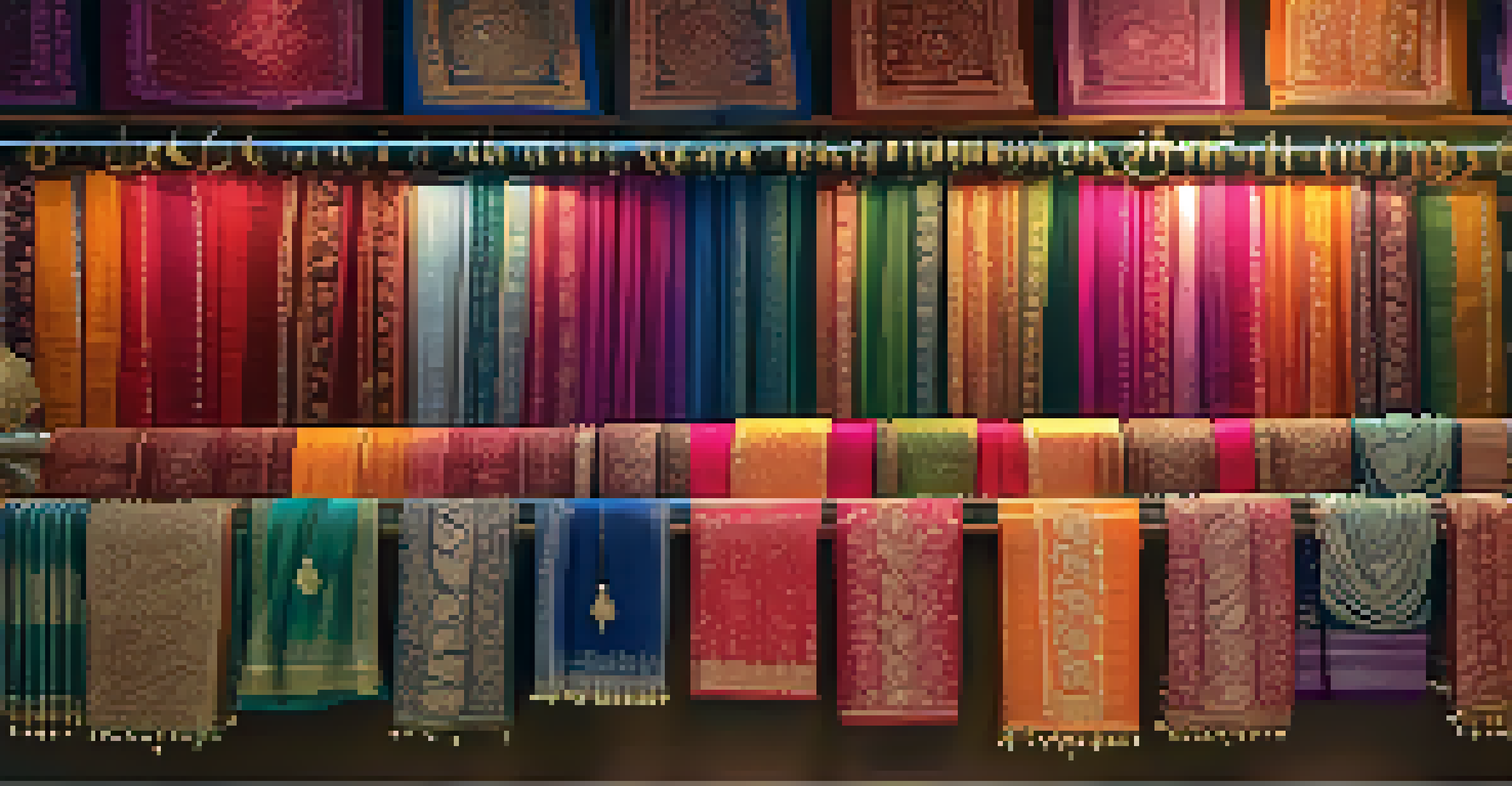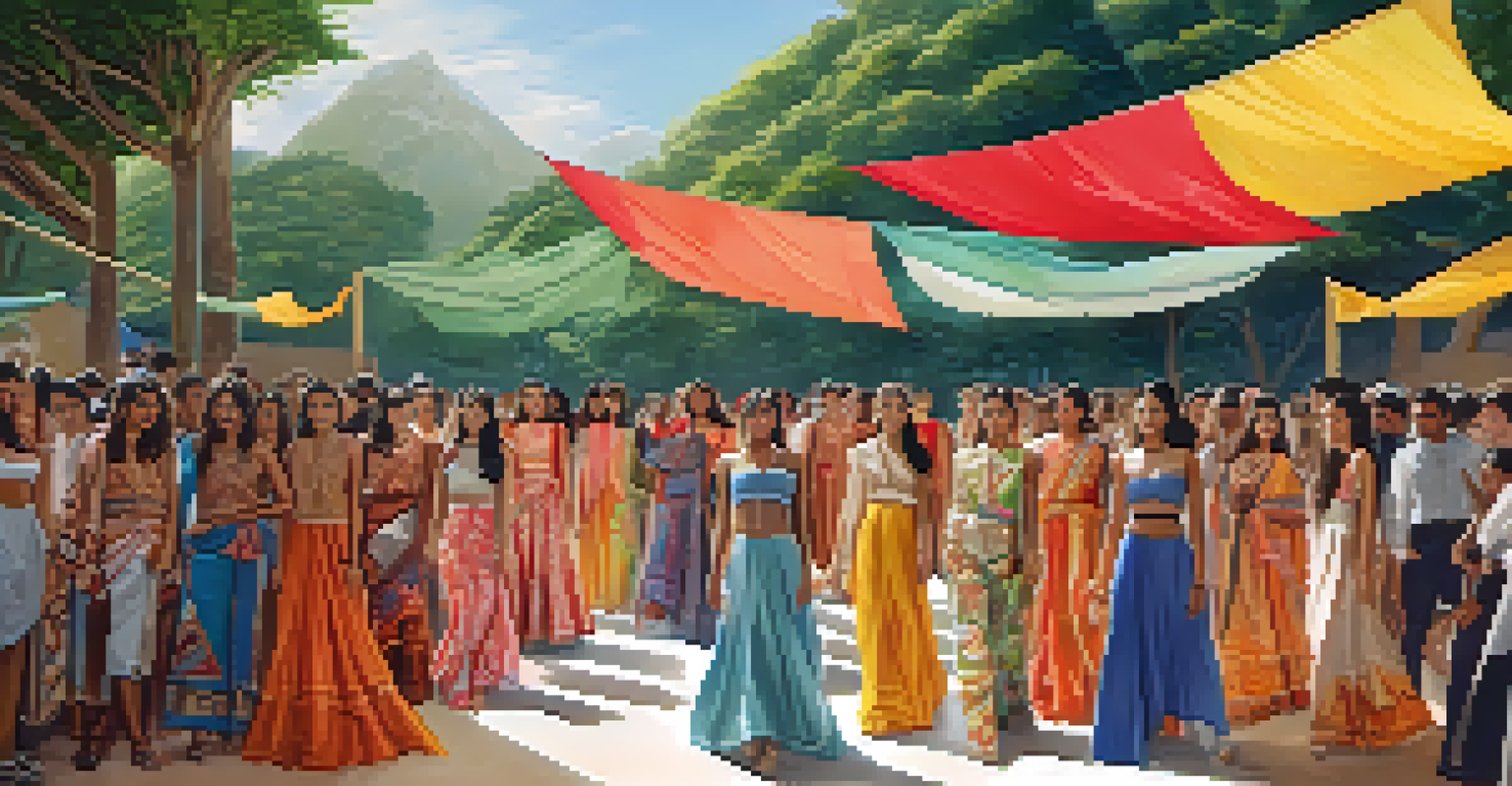Cultural Festivals: Driving Forces Behind Fashion Trends Worldwide

Cultural Festivals as Fashion Inspiration Sources
Cultural festivals are vibrant celebrations that showcase local traditions, art, and attire. They serve as a melting pot of creativity, where fashion designers draw inspiration from the colors, patterns, and styles seen in traditional garments. For example, the elaborate costumes worn during Rio Carnival highlight bold prints and feathers, inspiring designers to incorporate these elements into their collections.
Fashion is the armor to survive the reality of everyday life.
Moreover, these festivals often attract global attention, allowing local styles to transcend geographic boundaries. When a festival like Mardi Gras showcases unique outfits, it can spark interest and trends in fashion hubs around the world. This cross-pollination of ideas fosters innovation and keeps the fashion cycle fresh and exciting.
As fashion continues to evolve, cultural festivals remain a crucial touchpoint for designers looking to honor heritage while pushing creative boundaries. The essence of these celebrations resonates in modern fashion, reminding us that trends often have deep cultural roots.
The Role of Social Media in Amplifying Festival Fashion
In today’s digital age, social media plays a pivotal role in amplifying the trends born from cultural festivals. Platforms like Instagram and TikTok allow users to share their festival experiences, complete with stunning outfits and unique styles. This visibility helps lesser-known festivals gain traction and influence, showcasing diverse fashion choices to a global audience.

As influencers and fashion enthusiasts post their festival looks, they create a ripple effect that encourages others to adopt similar styles. For instance, the popularity of Coachella has led to a surge in bohemian-inspired fashion that transcends the festival itself. These platforms not only highlight the creativity of festival-goers but also inspire designers to incorporate new trends into their lines.
Cultural Festivals Inspire Fashion
Fashion designers draw rich inspiration from the vibrant colors, patterns, and styles showcased at cultural festivals.
Ultimately, social media acts as a bridge connecting cultural festivals to the wider fashion landscape. It democratizes fashion influence, allowing anyone with a passion for style to contribute to the conversation and shape trends.
Cultural Significance Behind Festival Attire
Fashion at cultural festivals often holds deep significance, representing history, identity, and community values. Each garment or accessory can narrate a story, reflecting the wearer's background and cultural heritage. For example, the intricate designs of traditional Indian sarees often symbolize regional craftsmanship and familial ties.
Style is a way to say who you are without having to speak.
These styles are not just fashion statements; they serve as a means of preserving cultural narratives and fostering pride within communities. When people wear traditional attire during festivals, they are participating in a collective memory, connecting past generations with the present. This connection enriches the overall experience of the festival, making it more than just a visual spectacle.
As global fashion continues to evolve, it's essential to recognize and respect the cultural significance behind festival attire. By doing so, the fashion industry can celebrate diversity while promoting inclusivity and understanding.
Eco-Friendly Fashion Trends from Cultural Celebrations
In recent years, many cultural festivals have embraced eco-friendly practices, influencing sustainable fashion trends. As awareness grows around environmental issues, designers and festival organizers are exploring innovative ways to reduce their carbon footprint. This includes using sustainable materials and promoting upcycling, which not only respects the environment but also highlights the artistry behind fashion.
For example, festivals like the Glastonbury Festival in the UK have seen a rise in recycled fashion, encouraging attendees to wear second-hand outfits. This trend not only minimizes waste but also offers unique style opportunities, as no two vintage pieces are alike. Such initiatives inspire designers to think creatively about how they can incorporate sustainability into their collections.
Social Media Amplifies Festival Trends
Platforms like Instagram and TikTok elevate festival fashion, allowing trends to reach a global audience and inspire new styles.
The fusion of cultural celebration and eco-consciousness is setting a precedent for the future of fashion. It encourages a shift towards more mindful consumption, reminding us that celebrating culture and protecting the planet can go hand in hand.
Global Fusion: Blending Cultural Styles at Festivals
Cultural festivals often embody a global fusion of styles, where diverse influences blend to create unique fashion statements. As attendees from various backgrounds come together, they showcase their cultural attire, leading to a vibrant mix of styles. This melting pot effect can be seen at festivals like the Edinburgh Fringe Festival, where traditional Scottish kilts meet contemporary streetwear, creating a fresh aesthetic.
This blending of styles not only reflects the interconnectedness of our world but also encourages creativity and experimentation in fashion. Designers who attend these festivals often draw inspiration from this cultural exchange, leading to innovative collections that celebrate diversity. For instance, the combination of African prints with Western silhouettes has become a trendy choice, showcasing the beauty of cross-cultural collaboration.
As the world becomes more interconnected, cultural festivals stand as a testament to the beauty of fusion in fashion. They remind us that inspiration can come from anywhere, encouraging a more inclusive approach to design.
Fashion Shows: A Spotlight on Cultural Festival Styles
Fashion shows often look to cultural festivals to showcase the latest trends and styles, turning the spotlight on these vibrant celebrations. Designers frequently draw from festival aesthetics to create collections that resonate with cultural themes. By featuring designs inspired by traditional garments, fashion shows can elevate the significance of these festivals to a broader audience.
For instance, the New York Fashion Week has seen collections inspired by events like Diwali and Chinese New Year, where traditional motifs and colors are reimagined for a contemporary audience. This not only honors the cultural significance of these festivals but also introduces them to a new demographic, creating a greater appreciation for global diversity in fashion.
Cultural Attire Holds Deep Significance
Festival attire often reflects cultural heritage and identity, serving as a means to preserve stories and foster community pride.
In this way, fashion shows serve as a platform for cultural storytelling, allowing designers to share their inspirations while educating audiences about the rich traditions behind the garments. The marriage of festival aesthetics and high fashion creates a dialogue that celebrates both innovation and history.
The Future of Fashion and Cultural Festivals
As we look to the future, the relationship between fashion and cultural festivals is poised to grow even stronger. With a global focus on sustainability, inclusivity, and diversity, festivals will continue to inspire designers and fashion enthusiasts alike. The rise of virtual festivals also opens up new avenues for showcasing cultural attire, allowing for even broader participation and influence.
Moreover, as cultural festivals adapt to modern sensibilities, they will likely incorporate technology, such as augmented reality, to enhance the fashion experience. This integration can elevate the visibility of traditional garments while appealing to a tech-savvy audience. The potential for innovation is vast, paving the way for exciting developments in the fashion industry.

Ultimately, the future of fashion and cultural festivals looks bright, with endless possibilities for creativity and connection. As we celebrate our diverse heritage through fashion, we can continue to inspire trends that reflect the rich tapestry of human experience.